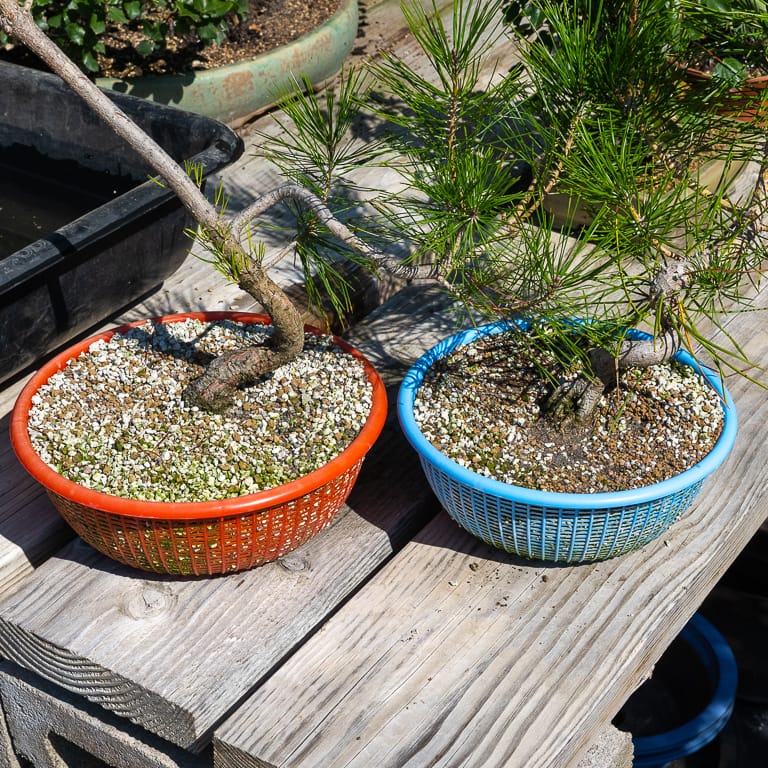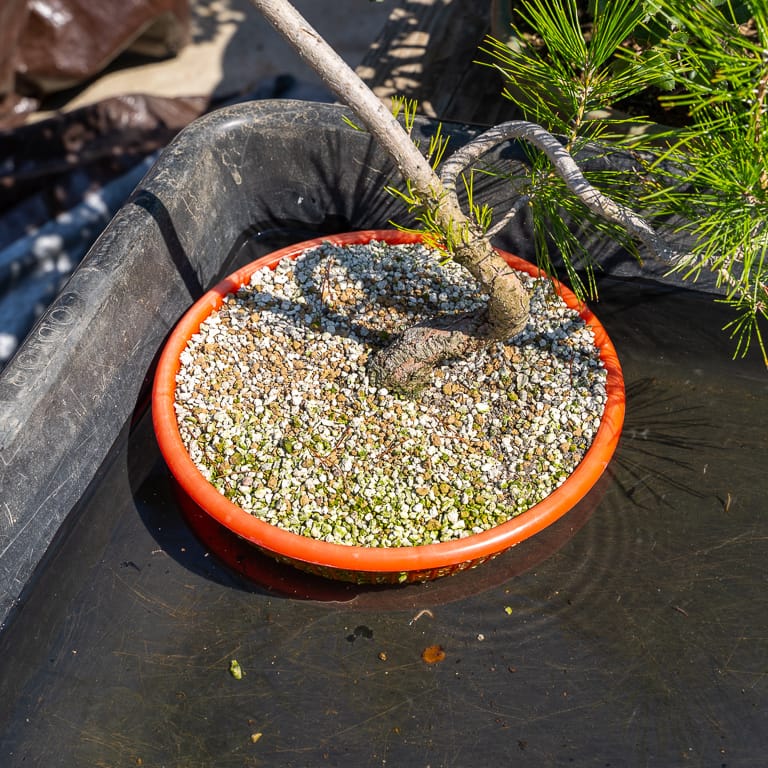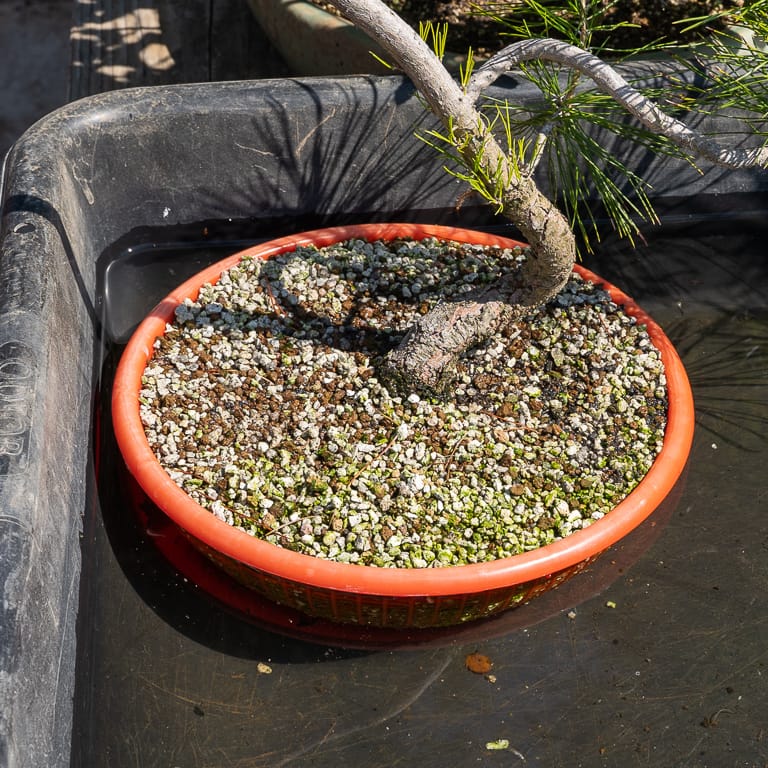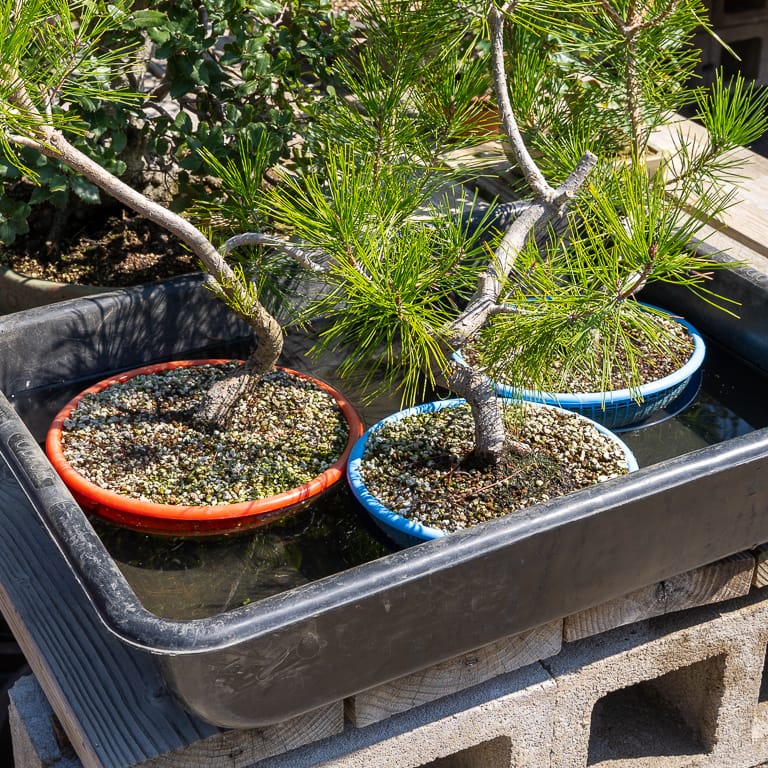Have you ever found that some trees dry out a lot faster than others this time of year? It happens a lot in my garden, on old trees and young trees alike.
One thing that can cause this is not watering thoroughly. Sometimes, I’ll water a tree three or four times only to dig down in the soil and find that the core is still dry. When this happens, it’s time to get out a water basin and soak the rootball.
Here are two pines growing in colanders. I can tell by the weight of the trees that the soil is dry. They are good candidates for a soak.

Young pines in need of a good watering
I’ll water the trees by setting them in a basin and filling it with water just below the lip of the pot (filling it higher will cause the pumice to float away).

Dry tree in the basin
After five-to-fifteen minutes of soaking, I can usually see signs that the soil is saturated.

Wet akadama on the surface of the soil
I’ll leave the trees in the water for as long as it takes to ensure the rootball is saturated. If I check after fifteen minutes and find dry soil in the core, I’ll let the tree soak some more or pierce the soil with a pick to help the water penetrate.
Even if I’m watering dozens of trees, I find it goes quickly as long as I’m working on something else in the meantime. Every time I walk by the basin, I pick up the wet trees and return them to the bench where I find more trees in need of watering.

Pines soaking
A good time to do this is right ahead of a warm spell. If you know that the temperatures are about to rise and there’s a chance some of the rootballs in the garden are dry, it could be time to give those trees a good soak.
Subscribe to Bonsai Tonight
New Posts Delivered Every Tuesday and Friday
Bartholomew says
That is interesting, especially if You consider that pines in general are drought-tolerant trees. How often do You recommend to perform such operation? I mean on pines. BR
Jonas Dupuich says
Thanks for the note Bartholomew! Pines are relatively drought tolerant and like to be kept on the dry side, but there’s a big difference between “on the dry side” and “dry.” I recommend doing this when necessary. If the water saturates the entire rootball of a tree every time its watered, it doesn’t need soaking. Other trees might need soaking once or twice a month – or more if the soil is really dense.
Zack Clayton, CBS Editor says
Jonas, It looks like you have a fairly porous soil mix. Assuming that your soil is uniform throughout the pot, what is causing the root ball to remain dry after a normal watering? It looks like water should penetrate all the soil volume easily. Is it indication of a need to repot in spring, or is it something else?
BTW, I link to your articles frequently in the Columbus newsletter, I would like to share those with you as the originating author. Can you send me your email for our mailing list?
Jonas Dupuich says
Hi Zack! The top layer of soil is in good shape but much of the soil has broken down over the years in the middle of the rootball. Because there’s such a big difference between the drainage in the new soil and the drainage in the center, it’s easy for the water to run right past the block in the middle. This is less of an issue in pots as slower drainage gives more of the rootball time to soak in every day, but the water can easily run out the sides in colanders.
Some of these trees need repotting and others don’t. Just to be on the safe side, I soaked all of my colander pines yesterday. The really dry ones floated even after 30 minutes of soaking.
Thanks for the links! I’ve seen some of the recent ones – it’s quite a newsletter. My email is at the bottom of the page.
Charlie Mosse says
You are spot on with soaking to improve wetting of the soil particles. I did the same trials at my house after you discussed this with me while when I visited with you at your nursery. I observed those same results of dry pockets especially on older soils as they break down and compact, or if original garden/nursery soils remain. This watering method is a must for shohin and Kifu sized trees, and older compacted soils in particular. It was less of a problem with new soil except that , as you pointed out, the individual soil particles many times do not get re-wetted with regular over head watering, even when dunking for too short a period of time. So every so often I soak them as you do but, over head watering is still done to wash off bugs and dust as well as to wash salts out a bit. All-in-all, a real eye opener when closely examining the root balls of many trees after each type of watering. I opened up some root balls of “unimportant” trees by digging into them, some by removing from pots and observing, and some by removing from pots and cutting the root ball open.
I have also started adding fertilizer to the soaking tub. I usually use fish/kelp, acidifier, if needed, or just kelp or humic acids. Soaking in water and adding the liquid fertilizers is making a difference. I think that more fertilizer is retained by the soil particles, especially the akadama, soaking in the tub.
We’re having a mini-Santa Ana for a few days with hot dry air but no no real wind, thankfully. I started the round-robin of soaking starting with the older more compacted root balls, shohin and more sensitive plants yesterday and will water the compacted root balls and shohin this way for the next 3 days.
Thanks as always for your informative insights.
Jonas Dupuich says
Thanks, Charlie – it’s sounds like you’ve developing some great watering habits! I’ve done the same with the fertilizer in the basin. Although I haven’t measured the result carefully, it seems the trees green up quickly with this approach.
I also find that poking the rootball with an old screwdriver can make a big difference with really stubborn rootballs. For one small pine in a 6″ colander I had to poke the rootball about 50 times before bubbles stopped leaking out and the tree stopped trying to float.
Good luck with the heat. I’ve been moving more trees into shade when it gets toasty up here (it was 97 yesterday). Thanks again!
Rolf Mahler says
Hi Jonas,
That’s exactly what I experienced with my JBP in colanders!! Great info/article as usual!! Well done!
Cheers
Rolf from downunder
Jonas Dupuich says
Thanks Rolf – and good luck with your young pines!